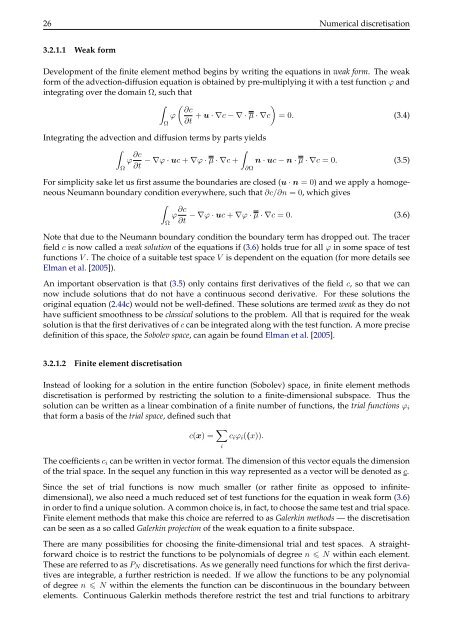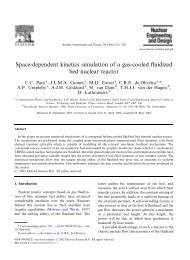Chapter 8 Configuring Fluidity - The Applied Modelling and ...
Chapter 8 Configuring Fluidity - The Applied Modelling and ...
Chapter 8 Configuring Fluidity - The Applied Modelling and ...
Create successful ePaper yourself
Turn your PDF publications into a flip-book with our unique Google optimized e-Paper software.
26 Numerical discretisation<br />
3.2.1.1 Weak form<br />
Development of the finite element method begins by writing the equations in weak form. <strong>The</strong> weak<br />
form of the advection-diffusion equation is obtained by pre-multiplying it with a test function ϕ <strong>and</strong><br />
integrating over the domain Ω, such that<br />
� � �<br />
∂c<br />
ϕ + u · ∇c − ∇ · µ · ∇c = 0. (3.4)<br />
∂t<br />
Ω<br />
Integrating the advection <strong>and</strong> diffusion terms by parts yields<br />
�<br />
ϕ ∂c<br />
�<br />
− ∇ϕ · uc + ∇ϕ · µ · ∇c +<br />
∂t<br />
n · uc − n · µ · ∇c = 0. (3.5)<br />
Ω<br />
For simplicity sake let us first assume the boundaries are closed (u · n = 0) <strong>and</strong> we apply a homogeneous<br />
Neumann boundary condition everywhere, such that ∂c/∂n = 0, which gives<br />
�<br />
Ω<br />
∂Ω<br />
ϕ ∂c<br />
− ∇ϕ · uc + ∇ϕ · µ · ∇c = 0. (3.6)<br />
∂t<br />
Note that due to the Neumann boundary condition the boundary term has dropped out. <strong>The</strong> tracer<br />
field c is now called a weak solution of the equations if (3.6) holds true for all ϕ in some space of test<br />
functions V . <strong>The</strong> choice of a suitable test space V is dependent on the equation (for more details see<br />
Elman et al. [2005]).<br />
An important observation is that (3.5) only contains first derivatives of the field c, so that we can<br />
now include solutions that do not have a continuous second derivative. For these solutions the<br />
original equation (2.44c) would not be well-defined. <strong>The</strong>se solutions are termed weak as they do not<br />
have sufficient smoothness to be classical solutions to the problem. All that is required for the weak<br />
solution is that the first derivatives of c can be integrated along with the test function. A more precise<br />
definition of this space, the Sobolev space, can again be found Elman et al. [2005].<br />
3.2.1.2 Finite element discretisation<br />
Instead of looking for a solution in the entire function (Sobolev) space, in finite element methods<br />
discretisation is performed by restricting the solution to a finite-dimensional subspace. Thus the<br />
solution can be written as a linear combination of a finite number of functions, the trial functions ϕi<br />
that form a basis of the trial space, defined such that<br />
c(x) = �<br />
ciϕi((x)).<br />
i<br />
<strong>The</strong> coefficients ci can be written in vector format. <strong>The</strong> dimension of this vector equals the dimension<br />
of the trial space. In the sequel any function in this way represented as a vector will be denoted as c.<br />
Since the set of trial functions is now much smaller (or rather finite as opposed to infinitedimensional),<br />
we also need a much reduced set of test functions for the equation in weak form (3.6)<br />
in order to find a unique solution. A common choice is, in fact, to choose the same test <strong>and</strong> trial space.<br />
Finite element methods that make this choice are referred to as Galerkin methods — the discretisation<br />
can be seen as a so called Galerkin projection of the weak equation to a finite subspace.<br />
<strong>The</strong>re are many possibilities for choosing the finite-dimensional trial <strong>and</strong> test spaces. A straightforward<br />
choice is to restrict the functions to be polynomials of degree n � N within each element.<br />
<strong>The</strong>se are referred to as PN discretisations. As we generally need functions for which the first derivatives<br />
are integrable, a further restriction is needed. If we allow the functions to be any polynomial<br />
of degree n � N within the elements the function can be discontinuous in the boundary between<br />
elements. Continuous Galerkin methods therefore restrict the test <strong>and</strong> trial functions to arbitrary




